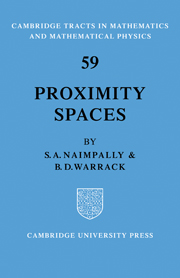Summary
The germ of the theory of proximity spaces showed itself as early as 1908 at the mathematical congress in Bologna, when Riesz discussed various ideas in his ‘theory of enchainment’ which have today become the basic concepts of the theory. The subject was essentially rediscovered in the early 1950's by Efremovič when he axiomatically characterized the proximity relation ‘A is near B’ for subsets A and B of any set X. The set X together with this relation was called an infinitesimal (proximity) space, and is a natural generalization of a metric space and of a topological group. A decade earlier a study was made by Krishna Murti, Wallace and Szymanski concerning the use of ‘separation of sets’ as the primitive concept. In each case similar, but weaker, axioms than those of Efremovič were used. Efremovič later used proximity neighbourhoods to obtain an equivalent set of axioms for a proximity space and thereby an alternative approach to the theory.
Defining the closure of a subset A of X to be the collection of all points of X ‘near’ A, Efremovič showed that a topology can be introduced in a proximity space and that one thereby obtains, in fact, a completely regular (and hence uniformizable) space. He further showed that every completely regular space X can be turned into a proximity space with the help of Urysohn's function: namely, A § B iff there exists a continuous function f mapping X into such that f(A) = 0 and f(B) = 1.
- Type
- Chapter
- Information
- Proximity Spaces , pp. 1 - 6Publisher: Cambridge University PressPrint publication year: 1971



